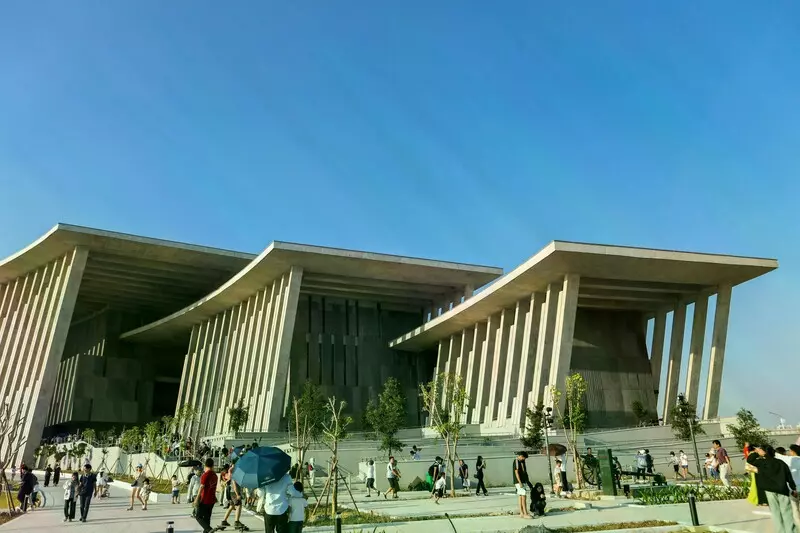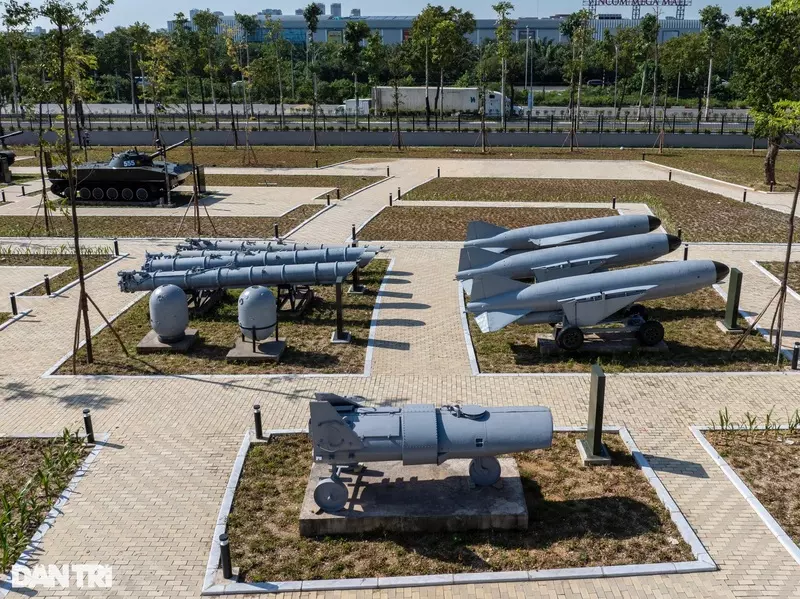The Vietnam Military History Museum is now located on Thang Long Boulevard (Tay Mo and Dai Mo wards, Nam Tu Liem district, Hanoi). This project was newly constructed by the Ministry of Defense in 2019, covering an area of over 386,600m² with a modern design and multiple functionalities. The article below by VnCarRentals.com will introduce visitors to the Vietnam Military History Museum for their upcoming trip.
Vietnam Military History Museum – A New Landmark Showcasing the Strength of the Vietnam People’s Army
- Address: Km 6+500, Thang Long Boulevard, Tay Mo, Dai Mo Ward, Nam Tu Liem District, Hanoi City
- Phone: 0246.253.1367
Opening Hours
The Vietnam Military History Museum is open every day of the week (except Mondays and Fridays).
- Morning hours: 8:00 AM – 11:30 AM
- Afternoon hours: 1:00 PM – 4:30 PM
Ticket Prices
The Vietnam Military History Museum offers free admission for visitors from November 1 to the end of December 2024.
Transportation
The museum is located at Km6+500 Thang Long Boulevard (Tay Mo Ward, Nam Tu Liem District, Hanoi). Visitors can easily reach the museum by various means of transportation:
- By Bus: Take bus routes 71, 74, or 107, which have stops near the museum entrance along Thang Long Boulevard.
- By Private Vehicle: Travel along Thang Long Boulevard, approximately 30 minutes from the city center. Parking is available on the left side of the museum (from the Thang Long Boulevard entrance). The parking area is spacious, and current parking fees are waived.(Standard rates: 3,000 VND for motorbikes, 20,000 VND for cars)
- By Taxi or Private Car: For the safest and most comfortable trip, you can use a taxi or book a private car service in Hanoi through VnCarRentals.com.
Impressive Architecture Based on the Concept of “Sky, Earth, and Sea”
Grand and Remarkable Structure
Since 2019, the Ministry of Defense has invested in the construction of the new Vietnam Military History Museum in Tay Mo and Dai Mo wards, Nam Tu Liem district, covering an area of 386,600 square meters. The museum features a front courtyard, the Victory Tower, and a main building with four above-ground floors and one semi-basement floor. The construction area of the building is 23,198 square meters, with a total floor area of 64,640 square meters and a height of 35.8 meters.

The architecture of the museum is inspired by the concept of “Heaven, Earth, and Sea,” which are the three natural elements that formed the country and also represent the three main forces of our military. It can be said that the Vietnam Military History Museum is not only a facility displaying the history of warfare but also a shared space where visitors can interact and experience the heroic atmosphere throughout the journey of national independence fought by the Vietnam People’s Army.


The Victory Tower of the Vietnam Military History Museum stands at a height of 45 meters, representing the year 1945 when our nation gained independence. The top of the tower is cut at a 60-degree angle, forming a five-pointed star with overlapping layers, reaching toward the blue sky. Additionally, the pentagonal base of the tower symbolizes the five socialist social classes: intellectuals, farmers, workers, entrepreneurs, and soldiers.

Division of Areas in the Vietnam Military History Museum
The left and right wings of the Vietnam Military History Museum are outdoor exhibition areas, showcasing weapons and equipment used by the Vietnam People’s Army during the resistance wars against the French and Americans, as well as items used in training and combat readiness to safeguard the nation’s peace. Notable artifacts include the 85mm cannon, PT67 tank numbered 555, and MiG-17 aircraft numbered 2047.

On the right side of the museum, visitors can observe military weapons and equipment used by the French and Americans during the wars, including artillery, tanks, and infantry fighting vehicles. Noteworthy exhibits include the M-107 self-propelled artillery with a 175mm caliber, famously nicknamed the “King of the Battlefield.” Visitors can also see aircraft left behind by the U.S. military after the war, such as the A-37, CH-47, F-5E, and C-130 planes, along with dozens of other bombs and munitions.

In the wings of the main building, architects have skillfully arranged symbolic displays of Vietnam’s aspiration for peace. These include sculptures of branches, green shoots, and doves soaring from the wreckage of a B-52 aircraft. This area represents the value of peace and Vietnam’s desire for harmony with nations worldwide. A globe and reflective panels showcase Vietnam’s historical journey from the time of the Hung Kings to the 20th century, underscoring the sacrifices made for national independence and freedom.

Passing through the main hall, visitors will encounter the display of the “Silver Swallow” MiG-21 fighter jet numbered 4324. This impressive fighter jet is suspended by cables attached to the ceiling, creating the illusion of it soaring to protect the nation’s skies. Adjacent to the aircraft, a dynamic LED screen showcases the beauty of Vietnam alongside historical, cultural, and traditional narratives of the nation’s fight for independence.

During the Vietnam War, nine pilots operated the “Silver Swallow,” conducting 69 sorties, engaging the enemy 22 times, firing 16 times, and shooting down 14 U.S. aircraft between 1965 and 1967. The jet’s fuselage bears 14 red stars, each representing a downed enemy aircraft. This artifact was officially recognized as a National Treasure of Vietnam on January 14, 2015.

National Treasures on Display
The museum currently houses four recognized National Treasures:
- The MiG-21 fighter jet numbered 4324
- The MiG-21 fighter jet numbered 5121
- The T-54B tank numbered 843
- The “Battle Determination Map” from the Ho Chi Minh Campaign
Main Themes Exhibited Inside the Museum
The primary exhibition spaces on the first floor of the Vietnam Military History Museum are divided into six themes:
- Theme 1: The Early Periods of Nation Building and Defense.

- Theme 2: Defending Independence from 939–1858.
- Theme 3: Fighting Against French Colonialism to Achieve National Independence (1858–1945).
- Theme 4: Resistance Against French Colonial Aggression (1945–1954).

- Theme 5: Resistance Against American Aggression (1954–1975).
- Theme 6: National Construction and Defense (1976–Present).
These themes are presented chronologically and arranged in a coherent layout. Artifacts are clearly labeled with information about related events.
Notably, the exhibits are enhanced through various innovative methods, including:
- 3D mapping technology for dioramas.
- Interactive screens for information retrieval.
- Visual aids such as historical images and video clips.
- Audio guides for self-narrated tours.
- QR codes for scanning and accessing detailed information about the artifacts.
- Video presentations introducing significant campaigns, battles, and historical figures.
These approaches provide a dynamic and immersive experience for visitors to learn about Vietnam’s rich military history.
Virtual Experience with Modern VR 360 Technology
For those who are far away and unable to visit in person, the Vietnam Military History Museum offers a cutting-edge VR 360 experience on the YooLife platform. This allows you to explore the museum from the entrance to the various exhibition areas.

Using your mouse or a touchscreen, you can rotate 360 degrees and access comprehensive information, including:
- Navigation directions.
- A detailed list of artifacts.
- Descriptions and annotations.
You can now explore the Vietnam Military History Museum from the comfort of your home through VR360 technology at: vr360.yoolife.vn/bao-tang-lich-su-quan-su-viet-nam-zmuseumc118u26724.
Conclusion
The Vietnam Military History Museum is a meaningful landmark celebrating the 80th anniversary of the founding of the Vietnam People’s Army. We hope that the useful information provided by VnCarRentals.com will help visitors have an unforgettable experience during their visit.


